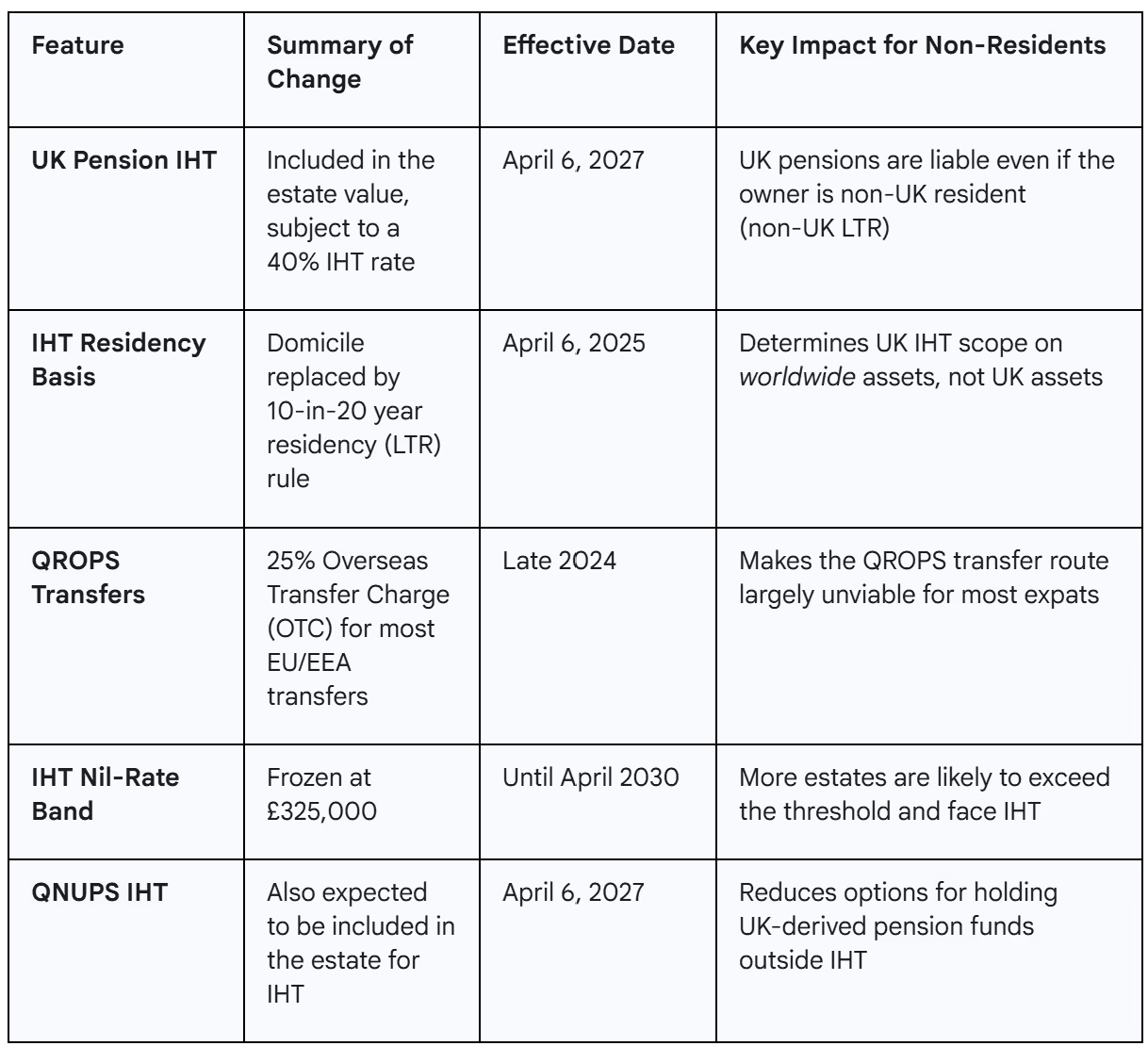Navigating the Storm: Understanding UK Inheritance Tax on Non-Resident Pensions
1. Introduction: A Major Shift for UK Expats and Their Pensions
Managing your UK pension while living abroad presents a unique set of challenges. As a UK expatriate or a former resident now settled overseas, you've likely spent considerable time planning your financial future, with your pension playing a central role. However, recent announcements from the UK government signal significant changes ahead, particularly concerning UK Inheritance Tax (IHT) and its application to pension funds. These developments are understandably causing concern and necessitate a closer look at existing arrangements.
Traditionally, UK pensions have been a cornerstone of financial planning, often viewed favourably from an estate planning perspective as they generally sat outside the scope of UK IHT upon death. This landscape, however, is undergoing a dramatic transformation. The rules are changing; understanding these shifts is crucial for protecting the wealth you've worked hard to build.
This article provides clarity on these upcoming changes. We will delve into how UK Inheritance Tax is set to apply to pensions held by non-UK residents, drawing upon the details released following recent UK budget announcements. Our focus will be specifically on the implications for you, as someone living outside the UK with ties to a UK pension, and the key factors to consider in your planning.
2. The Old Rules: Why Pensions Were Often Outside UK Inheritance Tax
Until now, defined-contribution pension funds have generally enjoyed a privileged status concerning IHT. Under the current rules, set to remain in place until April 2027, any funds left remaining in your pension pot upon your death can typically be passed on to your chosen beneficiaries without forming part of your estate for UK IHT calculation purposes. This exemption has made pensions an attractive vehicle not just for retirement savings, but also for efficient wealth transfer across generations.
For many expats, knowing that their pension savings could pass to loved ones without incurring a 40% IHT charge above the available thresholds, provided significant peace of mind and formed a key part of their estate planning strategy.
3. The Game Changer: UK Pensions Hit by Inheritance Tax from April 2027
The favourable IHT treatment described above is set for a fundamental overhaul. The UK government has announced that, from 6 April 2027, the rules will undergo significant changes. From this date, funds remaining in UK-registered pension schemes upon the member's death will generally be included when calculating the value of their estate for IHT purposes.
This means that these pension assets could become subject to UK IHT at the standard rate of 40% on the value that exceeds the deceased's available nil-rate band. Currently, the main nil-rate band stands at £325,000. It has been confirmed that this threshold will remain frozen until at least April 2030, a measure that is already bringing more estates into the IHT net due to asset growth.
Notably, this change applies regardless of the pension holder's residence at the time of their death. The scope of this change also extends beyond standard UK-registered schemes.
Based on initial analyses of the announcements, certain types of non-UK pension schemes that derive from UK funds, specifically Qualifying Non-UK Pension Schemes (QNUPS), are also expected to fall under these new IHT rules. While Qualifying Recognised Overseas Pension Schemes (QROPS) were not explicitly mentioned regarding IHT inclusion, both QROPS and QNUPS will most likely lose their ability to shelter wealth from UK IHT if the individual is deemed a UK long-term resident (LTR) at the time of death.
This ongoing process of monitoring and adapting to changes is a key part of responsible financial planning. The clear consequence is that a primary advantage previously associated with UK pensions – their exemption from IHT – is being removed. This necessitates a reevaluation of how pension wealth integrates into overall estate and wealth transfer planning for individuals residing abroad. What was once a relatively straightforward IHT shelter is becoming part of the taxable estate.
4. Understanding Your UK Tax Status: Domicile Out, Residency In
Alongside the pension changes, the UK is reforming how it determines liability for Inheritance Tax based on an individual's connection to the UK. The government is moving away from the often complex and subjective concept of 'domicile' and replacing it with a new system based on residency, effective from 6 April 2025.
Under the new framework, an individual's liability to UK IHT on their worldwide assets will be determined by a Long-Term Residency (LTR) test. This test generally considers you liable for UK IHT on your global estate if you have been resident in the UK for 10 out of the previous 20 UK tax years. Conversely, if you have lived outside the UK for at least 10 of the last 20 years, you will typically be classified as a non-UK long-term resident. This status generally means that your assets outside the UK fall outside the scope of UK IHT.
However, a transition period should be considered. Former UK residents may remain liable for UK IHT on their worldwide assets for up to 10 years after leaving the UK, depending on their specific residency history prior to departure. The aim is simplification, replacing the nuances of domicile with a more defined, time-based test.
While this shift to a residency test may seem simpler on the surface compared to the old domicile rules, it is crucial to understand its limitations, particularly in relation to UK-based assets. The new LTR status primarily determines whether your non-UK assets are subject to IHT. It does not automatically shield assets located within the UK from UK tax obligations.
5. Crucial Point: Non-Resident Status Won't Exempt Your UK Pension from IHT
This brings us to a critical point for expats and former residents holding UK pensions. Achieving non-UK resident status under the new LTR rules (by living outside the UK for more than 10 of the last 20 years) protects UK IHT on your worldwide assets; however, this protection does not extend to assets that are considered situated in the UK.
UK-registered pension schemes are unequivocally treated as UK-sited assets. Therefore, the upcoming inclusion of pensions within the scope of UK IHT from April 2027 will apply to these assets regardless of your personal residency status for IHT purposes.
The bottom line is stark: even if you have established long-term residency outside the UK and are considered a non-UK LTR, meaning your non-UK property and investments may be outside the UK IHT net, your UK pension fund will still be assessed for UK IHT upon your death from April 6, 2027. The geographic location or registration of the pension scheme itself effectively dictates its UK IHT liability in this context, overriding your non-resident IHT status concerning that specific asset.
6. What About Transferring Your Pension Overseas (QROPS)? The OTC Hurdle
Historically, transferring a UK pension to a Qualifying Recognised Overseas Pension Scheme (QROPS) was a strategy sometimes considered by expats. Depending on individual circumstances, domicile status (under the old rules), and the specific QROPS structure, this could offer various benefits, including mitigating UK IHT.
However, a significant barrier has recently been erected, significantly impacting this route. In late 2024, the UK government introduced a 25% Overseas Transfer Charge (OTC) on the value of pension funds transferred from the UK to a QROPS based in the European Union (EU) or European Economic Area (EEA). This substantial charge generally applies unless the individual transferring the pension is tax resident in the same country where the QROPS receiving the funds is established.
Given that the majority of QROPS providers operate from jurisdictions such as Malta and Gibraltar, this exemption from the OTC is effectively limited to residents of those specific countries The practical impact is clear: for the vast majority of UK expats living in popular destinations like France, Spain, Portugal, or other EU/EEA countries, initiating a QROPS transfer now triggers an immediate and significant 25% tax penalty on the entire fund value.
This change effectively renders the QROPS transfer route unviable or prohibitively expensive for most individuals it might previously have suited. Furthermore, as mentioned earlier, even if a transfer to a QROPS or QNUPS had occurred previously, these schemes themselves are affected by the new IHT rules coming into effect in 2027, particularly if the individual is deemed a UK LTR at the time of death.
The introduction of the OTC before the 2027 IHT changes take effect functions as a preemptive block, closing off the main established pathway for potentially moving pension funds outside the UK IHT net. This creates a significant planning challenge, leaving expats in a difficult position – potentially facing a 25% OTC now (if a suitable QROPS even exists and is desired) or leaving the pension in the UK to face 40% IHT later, alongside other potential taxes.
7. Beware the Potential "Double Tax Whammy"
Beyond the direct 40% IHT charge on the pension fund itself, beneficiaries may face an additional layer of taxation, potentially creating a "double tax whammy". This risk is particularly highlighted in scenarios where the pension holder passes away after reaching the age of 75. However, the interaction applies more broadly whenever IHT is due.
Here's how it could unfold:
- Layer 1: Inheritance Tax: First, the pension funds (above the available nil-rate band) are included in the deceased's estate, potentially triggering a 40% UK IHT liability, which the estate pays.
- Layer 2: Income Tax: Subsequently, when the beneficiary decides to draw funds from the inherited pension pot, these withdrawals are typically treated as income and are subject to income tax at the beneficiary's marginal rate. This income tax could be levied in the UK (where rates can reach 45%) or potentially in the beneficiary's country of residence, depending on double taxation agreements and local rules.
The combined effect of these two taxes could lead to a substantial reduction in the net amount ultimately received by your loved ones. One analysis projected a hypothetical scenario where the effective total tax rate could reach as high as 67%, drastically eroding the value passed on.
While specific outcomes depend on individual circumstances, the potential for significant value leakage is a serious concern. This double impact particularly affects larger pension funds that exceed the IHT threshold, fundamentally altering the wealth transfer equation for those with substantial retirement savings.
8. Planning Considerations for Expats and Former Residents
Given these profound changes, taking a passive approach is no longer advisable. Proactive planning is essential, ideally undertaken well before the April 2027 deadline when pensions become subject to IHT.
The first step is to conduct an urgent review of your current UK pension arrangements and your overall estate plan.. It is important to understand the potential impact of these new rules on your specific situation.
Following this review, several potential strategies may warrant consideration:
- Evaluate Pension Drawdown: Explore the possibility of accessing your UK pension funds now. If the tax treatment of pension income or lump sums in your country of residence is significantly more favourable than leaving the fund potentially exposed to 40% UK IHT plus subsequent income tax for beneficiaries, drawing down the pension might be an option. The viability of this depends heavily on the specifics of the Double Taxation Agreement (DTA) between the UK and your country of residence and local tax regulations.
- Consider Local Reinvestment: If drawing down your UK pension proves to be tax-efficient, you will then need a strategy for the capital that has been withdrawn. Reinvesting these funds into locally compliant, tax-efficient investment structures within your country of residence could be beneficial. Examples mentioned include products such as the Assurance Vie in France, as well as specific investment bonds available in Spain and Portugal. Offshore bonds or international investment accounts might also be suitable, depending on your jurisdiction.
- Asset Relocation (Non-Pension Assets): If you are aiming to secure non-UK LTR status to shield your worldwide assets from UK IHT, consider moving assets that are not UK pensions out of the UK. While this doesn't solve the UK IHT issue for your UK pension itself, it can help protect other parts of your estate if you meet the 10-year non-residency requirement.
Navigating these complexities requires a careful and personalised assessment. The interaction between UK tax law, the rules in your country of residence, and applicable Double Taxation Agreements (DTAs) is intricate. Therefore, seeking tailored, cross-border financial and tax advice from specialists experienced in both UK and local country regulations is strongly recommended. An advisor can help you understand your specific exposure and determine the most appropriate course of action based on circumstances, residency status, and long-term financial goals.
The removal of the UK pension IHT shelter and the restrictions on QROPS transfers necessitate a shift in focus towards understanding and utilising the tax rules and investment opportunities available in your country of residence.
Summary of Key UK Tax Changes Affecting Non-Resident Pensions
To help summarise the key changes discussed, the following table outlines the main points:

9. Conclusion: Act Now to Secure Your Financial Future
The landscape for UK pensions held by non-UK residents is undergoing a fundamental shift. The upcoming inclusion of UK pensions in the scope of Inheritance Tax, effective from April 2027, represents a significant change that requires your attention.
Key takeaways include the impending 40% IHT liability on UK pension funds, the replacement of domicile with new residency rules for determining worldwide IHT liability (which crucially does not exempt UK pensions), the severe restrictions placed on QROPS transfers by the 25% OTC, and the worrying potential for beneficiaries to face both IHT and subsequent income tax on inherited pension funds.
Delaying action is not advisable. The window for planning before these changes take full effect is closing.
We strongly encourage you to review circumstances, understand your potential exposure under the new rules, and seek professional, cross-border financial advice without delay. Taking proactive steps now is key to navigating these changes effectively and securing your financial legacy for the future.
If you would like some advice regarding UK Inheritance Tax on Non-Resident Pensions, please get in touch.







.avif)
